Temporal Scales of Mass Wasting Sedimentation across the Mississippi River Delta Front Delineated by 210Pb/137Cs Geochronology
Abstract
:1. Introduction
1.1. The Mississippi River Delta Front (MRDF)
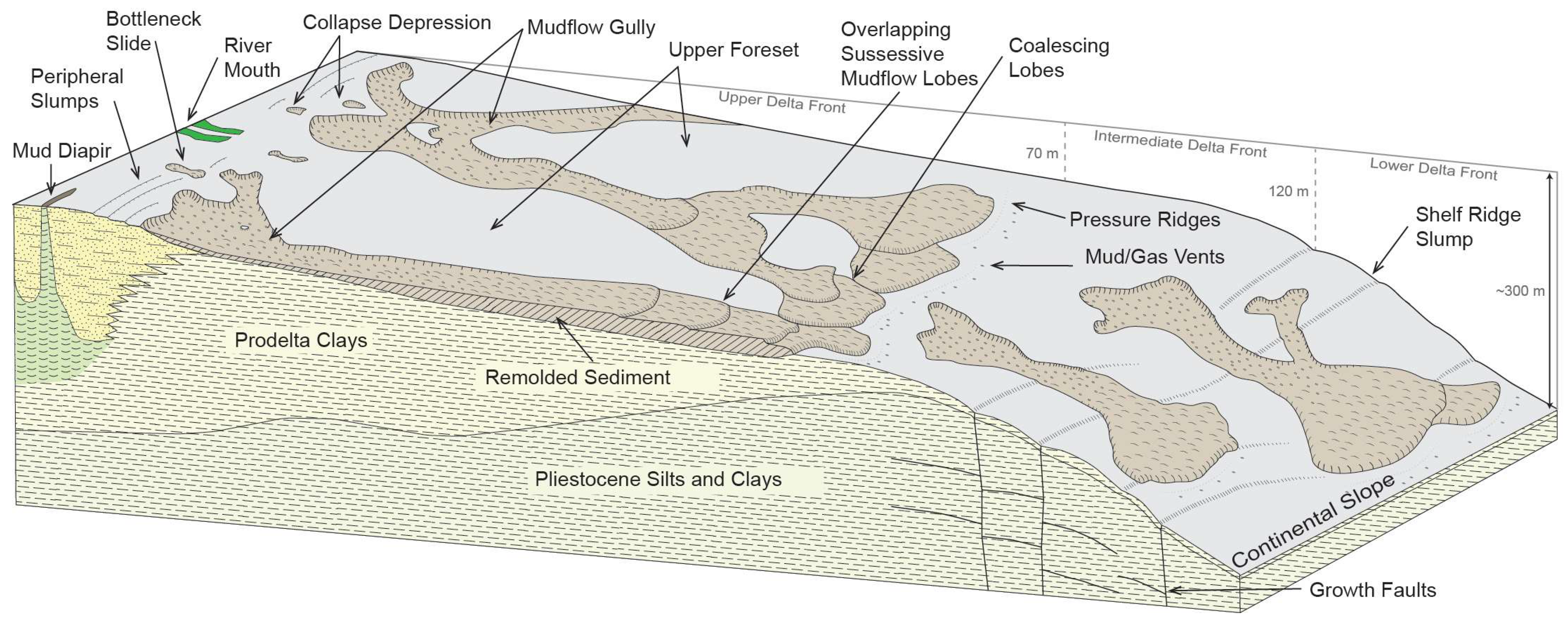
1.2. Background
1.2.1. Depositional Setting
1.2.2. Sediment Failure
- Fine sediment is transported seaward by river plumes with highest discharge at the SWP (20.8 Mt/y), and less so from the SP (4.7 Mt/y) and PL (4.8 Mt/y) [17]; this produces rapid sedimentation from plumes offshore of the river mouth, in spite of the historically declining sediment discharge overall [20]. Sediment deposits appear homogenous to finely stratified, and are comprised mostly of clay and silt, except for the uncommon sand-rich beds associated with layers from a hurricane event [21,22,23];
- Storm-generated surface gravity wave events create cyclic loading of the seabed at depths shallower than the wave base, which varies according to the height and period of the wave. Cyclic loading causes both compression and dilation of free gas where present [25], producing direct lateral pressure gradients between the wave crests and troughs [25]. Historically, most research on mass transport initiation has focused on waves generated by tropical cyclones studied in response to a loss of oil platforms and pipelines [15]. Recent work [8,13] shows that mass transport also occurs in the absence of hurricanes, although direct measurements of seabed motion are deficient [12,19,22,24,27].
1.2.3. Delta Front Morphology
2. Materials and Methods
2.1. Field Work/Core Processing
2.2. Gamma Density/Porosity
2.3. Grain Size
2.4. X-Radiographic Imaging
2.5. Radionuclide Analysis
2.6. Multibeam Bathymetry and CHIRP Seismic Profiles
3. Results
3.1. Physical Properties (Gamma Density/Porosity)
3.2. Grain Size Analysis
3.3. X-Radiography
3.4. Radioisotope Geochronology
3.4.1. Southwest Pass Cores
3.4.2. South Pass Cores
3.5. Excess 210Pb Inventories and Focusing Factors
3.6. CHIRP Seismic Survey
4. Discussion
4.1. Systematic Variations of Geological and Geochronological Parameters
4.2. Depositional Processes and Associated Diagnostic Depositional Features
- Hypopycnal fluvial sedimentation: The sediment deposits are out of suspension from the hypopycnal (buoyant) river discharge plumes [1,53,54]. Undisturbed sediment in the surrounding delta front (non-gully) floor has a linearly increasing gamma density profile with increasing depth (approx. 1.51 g/cm3 to 1.60 g/cm3). The grain size associated with this process is ~6.5 to 7.5 ɸ with sawtooth patterns at a 0.2 ɸ scale. Where continuous hypopycnal sedimentation is present (primarily in the undisturbed topset apron and the prodelta), 210Pb activity displays a log-linear downward decline with high r2 linear regression values and relatively low depositional rates, as listed in Table 1(PS17-03: r, 0.76; SAR, 4.20 cm/y; PS17-38: r2, 0.92; SAR, 0.80 cm/y) (Table 1 and Table 2). On X-radiography sediment fabrics (Figure 4) display laminations associated with hypopycnal depositions in PS17-03, with PS17-38 showing faint and partially bioturbated laminations.
- Hydrodynamic sedimentation event: The sediment was resuspended by elevated wave–current shear stresses producing an erosional base and normal graded bedding with coarser layers that are sufficiently thick to produce elevated gamma density (0.4–1.0 g/cm3 increase) [2,11,32,58,59]. Examples of this occur in PS17-03 (~20 cm depth) and PS17-09 (~50 cm depth). The GS increases with these events to ~5.8 ɸ (Figure 3) from an ambient GS of ~7 ± 0.5 ɸ [22,53]). 210Pb and 137Cs were analyzed at 6–12 cm spacing and do not show any obvious variation in the event layers, possibly because of the low spatial resolution for radioisotope analyses. X-radiography shows that event layers are subject to bioturbation, such as in PS17-09 (Figure 4d). Hydrodynamic events are evident in the topset apron and prodelta of the SW pass (PS17-03; PS17-09), and in the SP apron with its modest gamma density increase. X-radiographic images display clear cm- to mm-scale layering, such as in core PS17-09, possibly due to the event cycles (Figure 4d).
- Gravity-driven sedimentation event (mudflow): Gravity-driven mudflows initiated by a range of processes produce poorly consolidated homogenous sediment containing higher concentrations of biogenic gas voids [1,12,60]. Submarine landslide facies can be identified by a tiered/stair-stepped 210Pb profile collocated with abrupt changes in gamma density and sediment fabric changes, as well as being basally bounded by convolute bedding and a discontinuity visible in X-radiographs [2]. Beds with these properties are prevalent in the mudflow gully and lobe cores. The GS profiles show varied fluctuations within the gravity-driven sections, with GS mirroring the gamma density in some cases (370 to 500 cm in PS17-06) and increasing abruptly at the base of the mudflow layer in others (200 to 360 cm in PS17-06). 210Pb profiles indicate the clearest boundaries between events with clearly defined stair steps in PS17-06 and PS17-24 (mudflow gully cores), with vertical profiles indicating homogenized sediment flowing downslope. Less distinctive profiles are also present in both mudflow lobe cores (PS17-07; PS17-30) in smaller, dm-scale repeating packages. The 137Cs basement in PS17-24 corelates to both the gamma density and 210Pb stair step, indicating newer sediment sliding over older pre-1953 deposits, supported by a possible erosional unconformity observed at the base of the stair step (Figure 4e). This directly overlies the sediment which resumes a typical gamma density consolidation profile, as seen in adjacent apron cores.
4.3. Return Periods within Gullies
4.4. Mudflow Preconditioning and Potential Triggers
4.5. Trigger Events and Return Periods
4.6. Apparent Decline in Recent SARs
4.7. Radioisotope Inventories
5. Conclusions
- The mass movement and subsequent deposition within gully flows are identifiable up to a 6 m depth with 210Pb stair step profiles and corresponding gamma density fluctuation, as well as basement of 137Cs activity. This corelates with previous work by Keller et al. (2017) [2] and is further supported by the stratigraphic unconformities (possibly erosional) observed at the base of event layers.
- The mudflow gully event return periods within the SWP and SP are roughly decadal (10.7 years between events) and multi-decadal (66.7 y), respectively. The average return periods for all depositional environments in the SWP (17.8 y) are nearly seven times more frequent than those of the deeper, more distal SP (126 y). This supports its role in the formation of proximal-accumulation-dominated subaqueous depocenters [31] such as the MRDF.
- 210Pb Inventories and focusing factors display higher levels in the SWP overall with focusing factors centering around the SWP gully, indicating the preferential loading of sedimentation onto proximal environments and the distal transport via mudflow gullies. Deeper, more distal environments such as the SWP lobes and the prodelta, as well as all of the SP environments, show equilibrium to depleted sediment focusing in comparison.
- Recently dated mudflow deposits of varied scale are present in both the SP and SWP despite the former having a fraction of the sediment load and discharge, as well as a doubling of the depth and distance from its respective channel outlet. Moreover, the presence of a depositional shift to lower SARs in most cores, dated to after the construction of Mississippi River distributary dams, shows the visible impact of anthropogenic river engineering on the relative sediment delivery into the receiving basin.
Author Contributions
Funding
Institutional Review Board Statement
Informed Consent Statement
Data Availability Statement
Acknowledgments
Conflicts of Interest
References
- Coleman, J.M.; Walker, H.J.; Grabau, W.E. Sediment instability in the Mississippi River delta. J. Coastal Res. 1998, 872–881. [Google Scholar]
- Keller, G.; Bentley, S.J.; Georgiou, I.Y.; Maloney, J.; Miner, M.D.; Xu, K. River-plume sedimentation and 210Pb/7Be sea-bed delivery on the Mississippi River delta front. Geo-Mar. Lett. 2017, 37, 259–272. [Google Scholar] [CrossRef]
- Baldwin, W.E.; Ackerman, S.D.; Worley, C.R.; Danforth, W.W.; Chaytor, J.D. High-resolution geophysical data collected along the Mississippi River Delta front offshore of southeastern Louisiana. U.S. Geol. Surv. Field Act. 2018. [Google Scholar] [CrossRef]
- Coleman, J.M.; Roberts, H.H.; Stone, G.W. Mississippi River delta: An overview. J. Coastal Res. 1998, 699–716. [Google Scholar]
- Talling, P.J. On the triggers, resulting flow types and frequencies of subaqueous sediment density flows in different settings. Mar. Geol. 2014, 352, 155–182. [Google Scholar] [CrossRef]
- Nardin, T.R.; Hein, F.J.; Gorsline, D.S.; Edwards, B.D. A review of mass movement processes, sediment and acoustic characteristics, and contrasts in slope and base-of-slope systems versus canyon-fan-basin floor systems. Geo-Mar. Lett. 1979, 27, 61–73. [Google Scholar]
- Jiang, L.; LeBlond, P.H. Numerical modeling of an underwater Bingham plastic mudslide and the waves which it generates. J. Geophys. Res. Ocean 1993, 98, 10303–10317. [Google Scholar] [CrossRef]
- Obelcz, J.; Xu, K.; Georgiou, I.Y.; Maloney, J.; Bentley, S.J.; Miner, M.D. Sub-decadal submarine landslides are important drivers of deltaic sediment flux: Insights from the Mississippi River Delta Front. Geology 2017, 45, 703–706. [Google Scholar] [CrossRef]
- Allison, M.A.; Bianchi, T.S.; McKee, B.A.; Sampere, T.P. Carbon burial on river-dominated continental shelves: Impact of historical changes in sediment loading adjacent to the Mississippi River. Geophys. Res. Lett. 2007, 34–40, 34–40. [Google Scholar] [CrossRef]
- MMS Press Release MMS Updates Damage Assessment from Hurricane Ivan. MMS Updates Damage Assessment from Hurricane Ivan, U.S. Department of the Interior’s Minerals Management Service (MMS), 8 October 2004. Available online: https://www.bsee.gov/sites/bsee.gov/files/news/news-item/mms-press-release-1008a.pdf (accessed on 21 December 2022).
- Goni, M.A.; Alleau, Y.; Corbett, R.; Walsh, J.P.; Mallinson, D.; Allison, M.A.; Dellapenna, T.M. The effects of Hurricanes Katrina and Rita on the seabed of the Louisiana shelf. Sediment. Rec. 2007, 5, 4–9. [Google Scholar] [CrossRef]
- Guidroz, W.S. Subaqueous, Hurricane-Initiated Shelf Failure Morphodynamics along the Mississippi River Delta Front, North-central Gulf of Mexico. Ph.D. Thesis, Louisiana State University and Agricultural & Mechanical College, Baton Rouge, LA, USA, 2009. [Google Scholar]
- Chaytor, J.D.; Baldwin, W.E.; Bentley, S.J.; Damour, M.; Jones, D.; Maloney, J.; Xu, K. Short- and long-term movement of mudflows of the Mississippi River Delta Front and their known and potential impacts on oil and gas infrastructure. Geol. Soc. Lond. Spec. Publ. 2020, 500, 587–604. [Google Scholar] [CrossRef]
- Maloney, J.M.; Bentley, S.J.; Xu, K.; Obelcz, J.; Georgiou, I.Y.; Miner, M.D. Mississippi River subaqueous delta is entering a stage of retrogradation. Mar. Geol. 2018, 400, 12–23. [Google Scholar] [CrossRef]
- Anderson, J.B.; Wallace, D.J.; Simms, A.R.; Rodriguez, A.B.; Weight, R.W.; Taha, Z.P. Recycling sediments between source and sink during a eustatic cycle: Systems of late Quaternary northwestern Gulf of Mexico Basin. Earth-Sci. Rev. 2016, 153, 111–138. [Google Scholar] [CrossRef]
- Bentley Sr, S.J.; Blum, M.D.; Maloney, J.; Pond, L.; Paulsell, R. The Mississippi River source-to-sink system: Perspectives on tectonic, climatic, and anthropogenic influences, Miocene to Anthropocene. Earth-Sci. Rev. 2016, 153, 139–174. [Google Scholar] [CrossRef]
- Allison, M.A.; Meselhe, E.A. The use of large water and sediment diversions in the lower Mississippi River (Louisiana) for coastal restoration. J. Hydrol. 2010, 387, 346–360. [Google Scholar] [CrossRef]
- Allison, M.A.; Meselhe, E.A.; Kleiss, B.A.; Duffy, S.M. Impact of water loss on sustainability of the Mississippi River channel in its Deltaic Reach. Hydrol. Process. 2023, 37, e15004. [Google Scholar] [CrossRef]
- Jakob, M.; Hungr, O.; Jakob, D.M. Debris-Flow Hazards and Related Phenomena; Springer: Berlin/Heidelberg, Germany, 2005; Volume 739. [Google Scholar]
- Allen, J.R.L. The Bouma division A and the possible duration of turbidity currents. J. Sediment. Res. 1991, 61, 291–295. [Google Scholar]
- Courtois, A.; Bentley, S.; Maloney, J.; Xu, K.; Chaytor, J.; Georgiou, I.Y.; Damour, M. Short-Term Sediment Dispersal on a Large Retreating Coastal River Delta via 234Th and 7Be Sediment Geochronology: The Mississippi River Delta Front. Water 2024, 16, 463. [Google Scholar] [CrossRef]
- Dail, M.B.; Corbett, D.R.; Walsh, J.P. Assessing the importance of tropical cyclones on continental margin sedimentation in the Mississippi delta region. Cont. Shelf Res. 2007, 27, 1857–1874. [Google Scholar] [CrossRef]
- Walsh, J.P.; Corbett, R.; Mallinson, D.; Goni, M.; Dail, M.; Loewy, C.; Tesi, T. Mississippi delta mudflow activity and 2005 Gulf hurricanes. EOS Trans. Am. Geophys. Union 2006, 87, 477–478. [Google Scholar] [CrossRef]
- Bennett, R.H. Pore-water pressure measurements: Mississippi delta submarine sediments. Mar. Georesour. Geotechnol. 1977, 2, 177–189. [Google Scholar] [CrossRef]
- Anderson, A.L.; Bryant, W.R. Gassy sediment occurrence and properties: Northern Gulf of Mexico. Geo-Mar. Lett. 1990, 10, 209–220. [Google Scholar] [CrossRef]
- Chillarige, A.V.; Morgenstern, N.R.; Robertson, P.K.; Christian, H.A. Seabed instability due to flow liquefaction in the Fraser River delta. Can. Geotech. J. 1997, 34, 520–533. [Google Scholar] [CrossRef]
- Denommee, K.C.; Bentley Sr, S.J.; Harazim, D. Mechanisms of muddy clinothem progradation on the Southwest Louisi-ana Chenier Plain inner shelf. Geo-Mar. Lett. 2018, 38, 273–285. [Google Scholar] [CrossRef]
- Shanmugam, G. The Bouma sequence and the turbidite mind set. Earth-Sci. Rev. 1997, 42, 201–229. [Google Scholar] [CrossRef]
- Lindsay, J.F.; Prior, D.B.; Coleman, J.M. Distributary-mouth bar development and role of submarine landslides in delta growth, South Pass, Mississippi Delta. AAPG Bull. 1984, 68, 1732–1743. [Google Scholar]
- Hampton, M.A.; Lee, H.J.; Locat, J. Submarine landslides. Rev. Geophys. 1996, 34, 33–59. [Google Scholar] [CrossRef]
- Walsh, J.P.; Nittrouer, C.A. Understanding fine-grained river-sediment dispersal on continental margins. Mar. Geol. 2009, 263, 34–45. [Google Scholar] [CrossRef]
- Denommee, K.C.; Bentley, S.J.; Harazim, D.; Macquaker, J.H. Hydrodynamic controls on muddy sedimentary-fabric de-velopment on the Southwest Louisiana subaqueous delta. Mar. Geol. 2016, 377, 24–36. [Google Scholar]
- Bianchi, T.S.; Allison, M.A. Large river deltas and the carbon cycle: A review of the role of deltas in the global carbon cycle and implications for future climate change. Rev. Geophys. 2009, 47, 20. [Google Scholar]
- Neill, C.F.; Allison, M.A. Subaqueous deltaic formation on the Atchafalaya Shelf, Louisiana. Mar. Geol. 2005, 214, 411–430. [Google Scholar] [CrossRef]
- Septama, E.; Bentley, S.J., Sr. Late Quaternary geomorphology, seabed evolution, and terrigenous sediment delivery to the Pandora and Moresby Troughs, Gulf of Papua. Mar. Geol. 2016, 379, 208–223. [Google Scholar] [CrossRef]
- Bolton, A.; Maltman, A. Fluid-flow pathways in actively deforming sediments: The role of pore fluid pressures and volume change. Mar. Petrol. Geol. 1998, 15, 281–297. [Google Scholar] [CrossRef]
- Swarbrick, R.E. Pore-pressure prediction: Pitfalls in using porosity. In Proceedings of the Offshore Technology Conference, Houston, TX, USA, 30 April–3 May 2001. [Google Scholar]
- Figueredo, N.; Bentley, S.J.; Chaytor, J.D.; Xu, K.; Jafari, N.; Georgiou, I.Y.; Maloney, J. Sedimentary processes and instability on the Mississippi River Delta Front near the Shipwreck of the SS Virginia. Water 2024, 16, 421. [Google Scholar] [CrossRef]
- Fitzgerald, S.A.; Klump, J.V.; Swarzenski, P.W.; Mackenzie, R.A.; Richards, K.D. Beryllium-7 as a tracer of short-term sediment deposition and resuspension in the Fox River, Wisconsin. Environ. Sci. Technol. 2001, 35, 300–305. [Google Scholar] [CrossRef] [PubMed]
- Corbett, D.R.; Walsh, J.P. 210Lead and 137Cesium: Establishing a chronology for the last century. In Handbook of Sea-Level Research; John Wiley & Sons, Ltd.: Hoboken, NJ, USA, 2015; pp. 361–372. [Google Scholar]
- Guzmán, G.; Quinton, J.N.; Nearing, M.A.; Mabit, L.; Gómez, J.A. Sediment tracers in water erosion studies: Current approaches and challenges. J. Soils Sediment 1986, 13, 816–833. [Google Scholar] [CrossRef]
- Hülse, P.; Bentley Sr, S.J. A 210Pb sediment budget and granulometric record of sediment fluxes in a subarctic deltaic system: The Great Whale River, Canada. Estuar. Coast. Shelf Sci. 2012, 109, 41–52. [Google Scholar] [CrossRef]
- Olley, J.; Burton, J.; Smolders, K.; Pantus, F.; Pietsch, T. The application of fallout radionuclides to determine the dominant erosion process in water supply catchments of subtropical South-east Queensland, Australia. Hydrol. Process. 2013, 27, 885–895. [Google Scholar] [CrossRef]
- Blake, W.H.; Walling, D.E.; He, Q. Using cosmogenic beryllium–7 as a tracer in sediment budget investigations. Geogr. Ann. A Phys. Geogr. 2002, 84, 89–102. [Google Scholar] [CrossRef]
- Porto, P.; Walling, D.E.; Callegari, G. Using 137Cs and 210Pbex measurements to investigate the sediment budget of a small forested catchment in southern Italy. Hydrol. Process. 2013, 27, 795–806. [Google Scholar] [CrossRef]
- Walling, D.E. Beryllium-7: The Cinderella of fallout radionuclide sediment tracers? Hydrol. Process. 2013, 27, 830–844. [Google Scholar] [CrossRef]
- Corbett, D.R.; McKee, B.; Allison, M. Nature of decadal-scale sediment accumulation on the western shelf of the Mississippi River delta. Cont. Shelf Res. 2006, 26, 2125–2140. [Google Scholar] [CrossRef]
- Charles, M. UNSCEAR Report 2000: Sources and Effects of Ionizing Radiation; United Nations Publication: New York, NY, USA, 2000. [Google Scholar]
- Cochran, J.K.; Masqué, P. Short-lived U/Th series radionuclides in the ocean: Tracers for scavenging rates, export fluxes and particle dynamics. Rev. Mineral. Geochem. 2003, 52, 461–492. [Google Scholar] [CrossRef]
- Nittrouer, C.A.; Sternberg, R.W. The formation of sedimentary strata in an allochthonous shelf environment: The Washington continental shelf. In Developments in Sedimentology; Elsevier: Amsterdam, The Netherlands, 1981; Volume 32, pp. 201–232. [Google Scholar]
- Muhammad, Z.; Bentley, S.J.; Febo, L.A.; Droxler, A.W.; Dickens, G.R.; Peterson, L.C.; Opdyke, B.N. Excess 210Pb in-ventories and fluxes along the continental slope and basins of the Gulf of Papua. J. Geophys. Res. Earth Surf. 2008, 113, F1. [Google Scholar] [CrossRef]
- Moore, W.S.; Krest, J. Distribution of 223Ra and 224Ra in the plumes of the Mississippi and Atchafalaya Rivers and the Gulf of Mexico. Mar. Chem. 2004, 86, 105–119. [Google Scholar] [CrossRef]
- Baskaran, M.; Swarzenski, P.W. Seasonal variations on the residence times and partitioning of short-lived radionuclides (234Th, 7Be and 210Pb) and depositional fluxes of 7Be and 210Pb in Tampa Bay, Florida. Mar. Chem. 2007, 104, 27–42. [Google Scholar] [CrossRef]
- Zhang, Y.; Xu, M.; Wu, T.; Li, Z.; Liu, Q.; Wang, X.; Hou, G. Sources of fine-sediment reservoir deposits from contrasting lithological zones in a medium-sized catchment over the past 60 years. J. Hydrol. 2021, 603, 127159. [Google Scholar] [CrossRef]
- Droser, M.L.; Bottjer, D.J. A semiquantitative field classification of ichnofabric. J. Sediment. Res. 1986, 56, 558–559. [Google Scholar] [CrossRef]
- Gerland, S.; Villinger, H. Nondestructive density determination on marine sediment cores from gamma-ray attenuation measurements. Geo-Mar. Lett. 1995, 15, 111–118. [Google Scholar] [CrossRef]
- Keen, T.R.; Slingerland, R.L.; Bentley, S.J.; Furukawa, Y.; Teague, W.J.; Dykes, J.D. Sediment transport on continental shelves: Storm bed formation and preservation in heterogeneous sediments. In Sediments, Morphology and Sedimentary Processes on Continental Shelves: Advances in Technologies, Research, and Applications; John Wiley & Sons, Ltd.: Hoboken, NJ, USA, 2012; pp. 295–310. [Google Scholar]
- Allison, M.A.; Sheremet, A.; Goñi, M.A.; Stone, G.W. Storm layer deposition on the Mississippi–Atchafalaya subaqueous delta generated by Hurricane Lili in 2002. Cont. Shelf Res. 2005, 25, 2213–2232. [Google Scholar] [CrossRef]
- Cadigan, J.A.; Jafari, N.H.; Georgiou, I.Y. Mobilized shear strengths of Mississippi River Delta Front sediments during submarine landslides. Geo-Mar. Lett. 2022, 42, 8. [Google Scholar] [CrossRef]
- Ge, Z.; Nemec, W.; Vellinga, A.J.; Gawthorpe, R.L. How is a turbidite actually deposited? Sci. Adv. 2022, 8, eabl9124. [Google Scholar] [CrossRef]
- Wright, L.D.; Nittrouer, C.A. Dispersal of river sediments in coastal seas: Six contrasting cases. Estuaries 1995, 18, 494–508. [Google Scholar] [CrossRef]
- Sommerfield, C.K.; Nittrouer, C.A. Modern accumulation rates and a sediment budget for the Eel shelf: A flood-dominated depositional environment. Mar. Geol. 1999, 154, 227–241. [Google Scholar] [CrossRef]
- Clague, J.J. Evidence for large earthquakes at the Cascadia subduction zone. Rev. Geophys. 1997, 35, 439–460. [Google Scholar] [CrossRef]
- Donnelly, J.P.; Roll, S.; Wengren, M.; Butler, J.; Lederer, R.; Webb, T., III. Sedimentary evidence of intense hurricane strikes from New Jersey. Geology 2001, 29, 615–618. [Google Scholar] [CrossRef]
- Maloney, J.M.; Bentley, S.J.; Xu, K.; Obelcz, J.; Georgiou, I.Y.; Jafari, N.H.; Miner, M.D. Mass wasting on the Mississippi River subaqueous delta. Earth-Sci. Rev. 2020, 200, 103001. [Google Scholar] [CrossRef]
- Coleman, J.M. Dynamic changes and processes in the Mississippi River delta. Geol. Soc. Am. Bull. 1988, 100, 999–1015. [Google Scholar] [CrossRef]
- Donnelly, J.P.; Giosan, L. Tempestuous highs and lows in the Gulf of Mexico. Geology 2008, 36, 751–752. [Google Scholar] [CrossRef]
- Denommee, K.C.; Bentley, S.J.; Droxler, A.W. Climatic controls on hurricane patterns: A 1200-y near-annual record from Lighthouse Reef, Belize. Sci. Rep. 2014, 4, 3876. [Google Scholar] [CrossRef]
- Blum, M.D.; Roberts, H.H. Drowning of the Mississippi Delta due to insufficient sediment supply and global sea-level rise. Nat. Geosci. 2009, 2, 488–491. [Google Scholar] [CrossRef]
- Xu, K.; Bentley, S.J.; Day, J.W.; Freeman, A.M. A review of sediment diversion in the Mississippi River Deltaic Plain. Estuarine Coastal Shelf Sci. 2019, 225, 106241. [Google Scholar] [CrossRef]


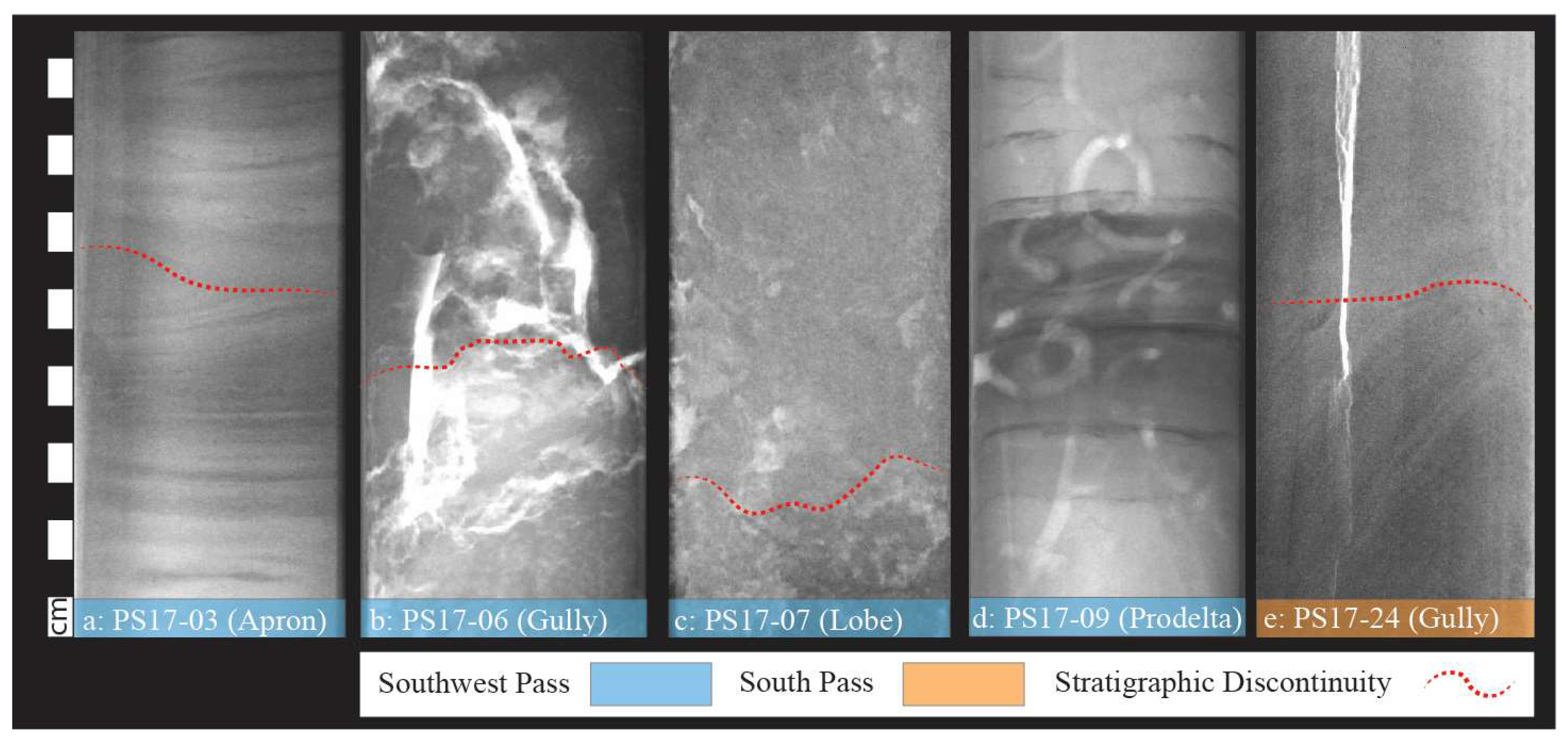
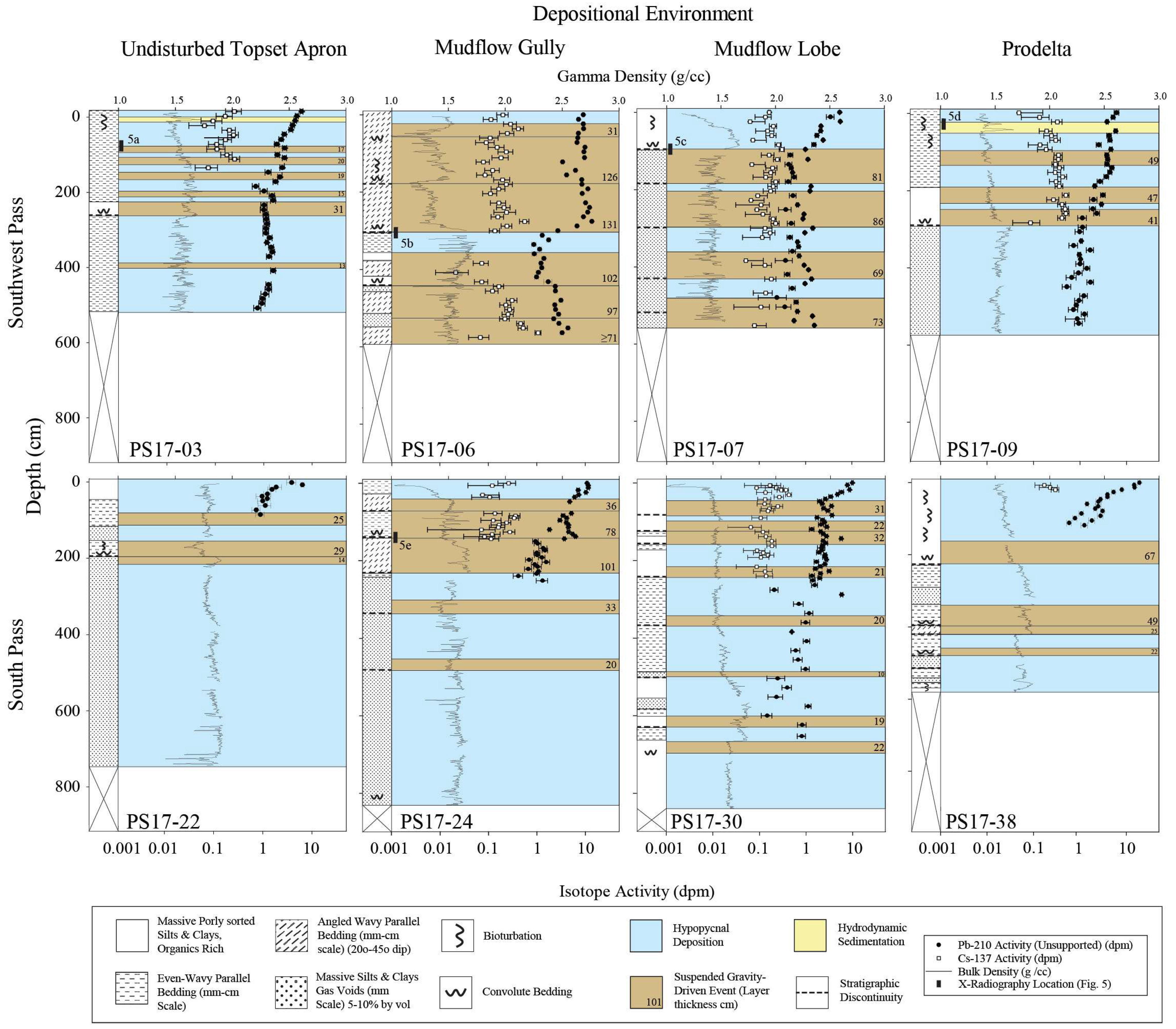
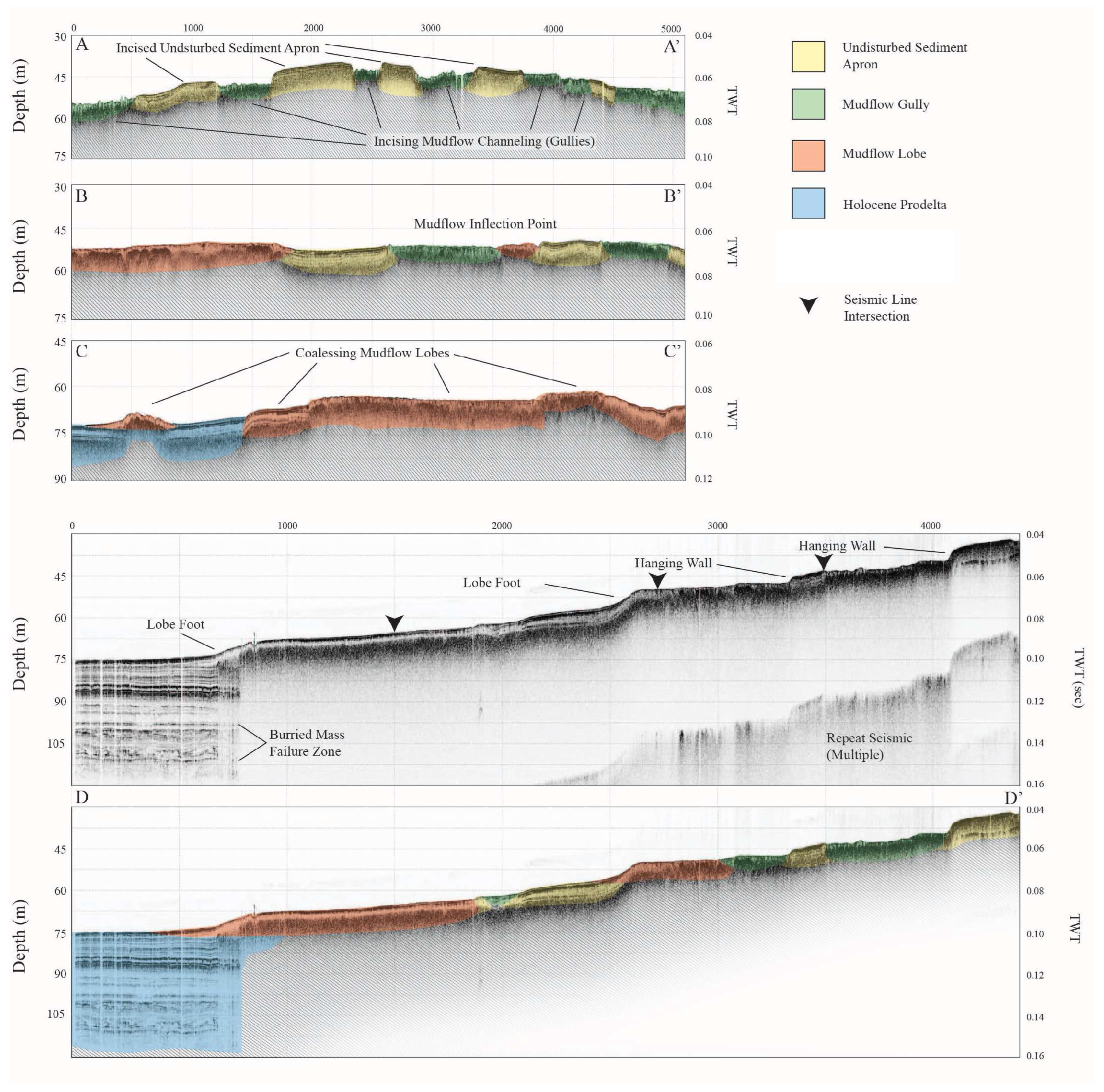
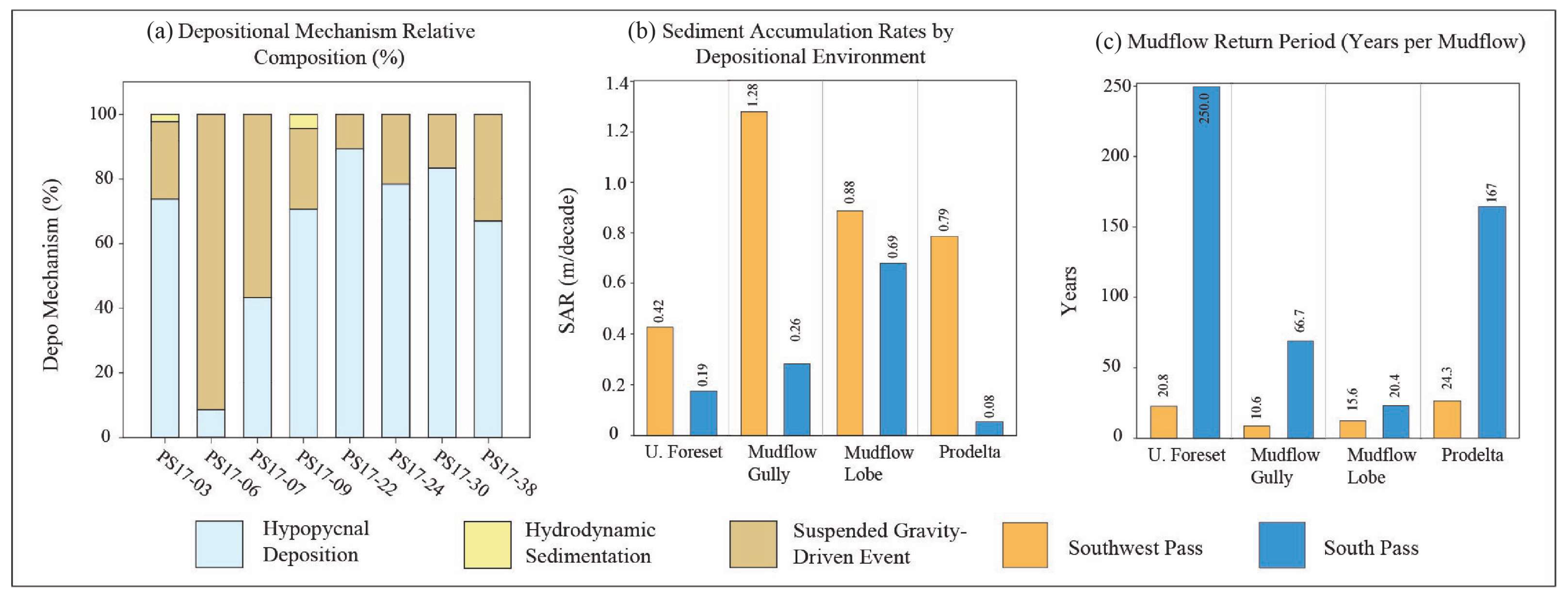
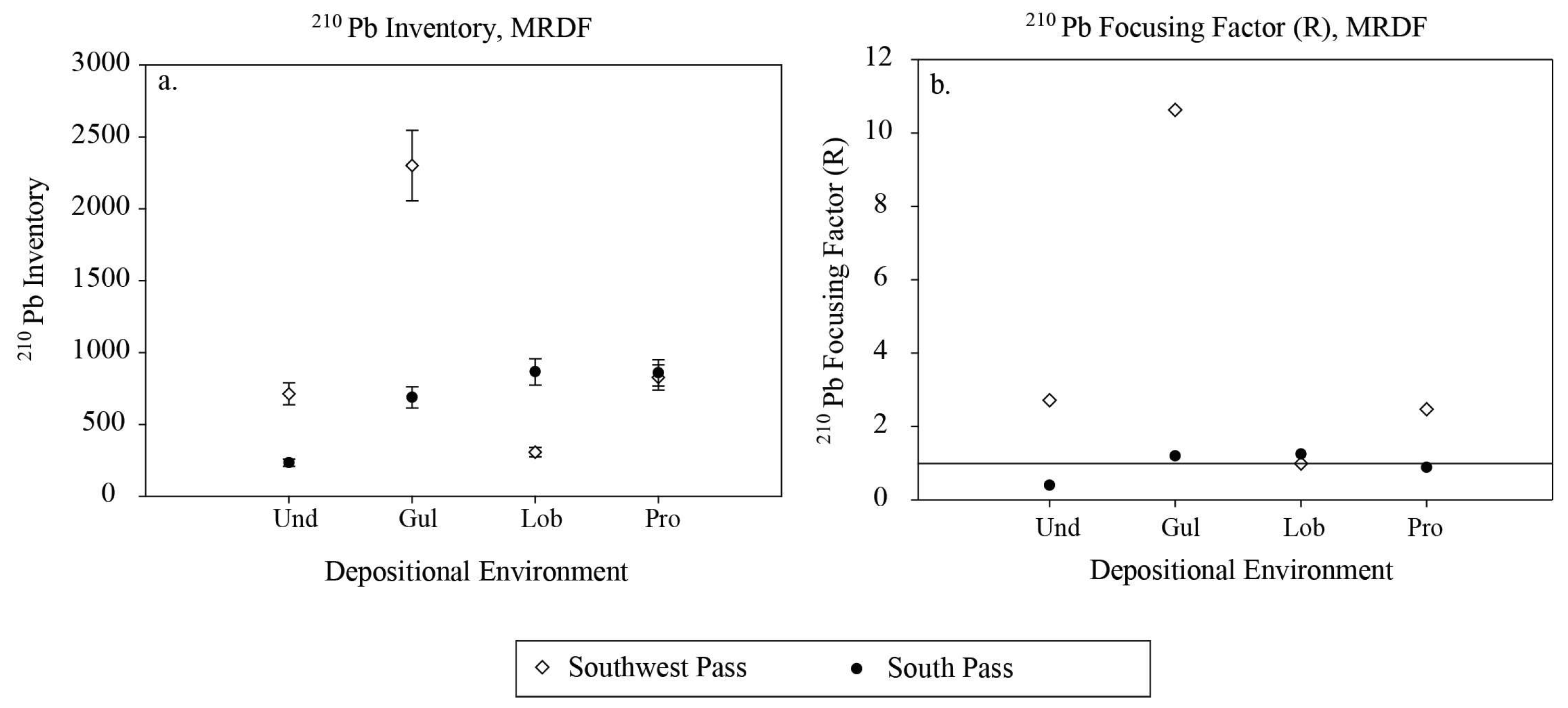
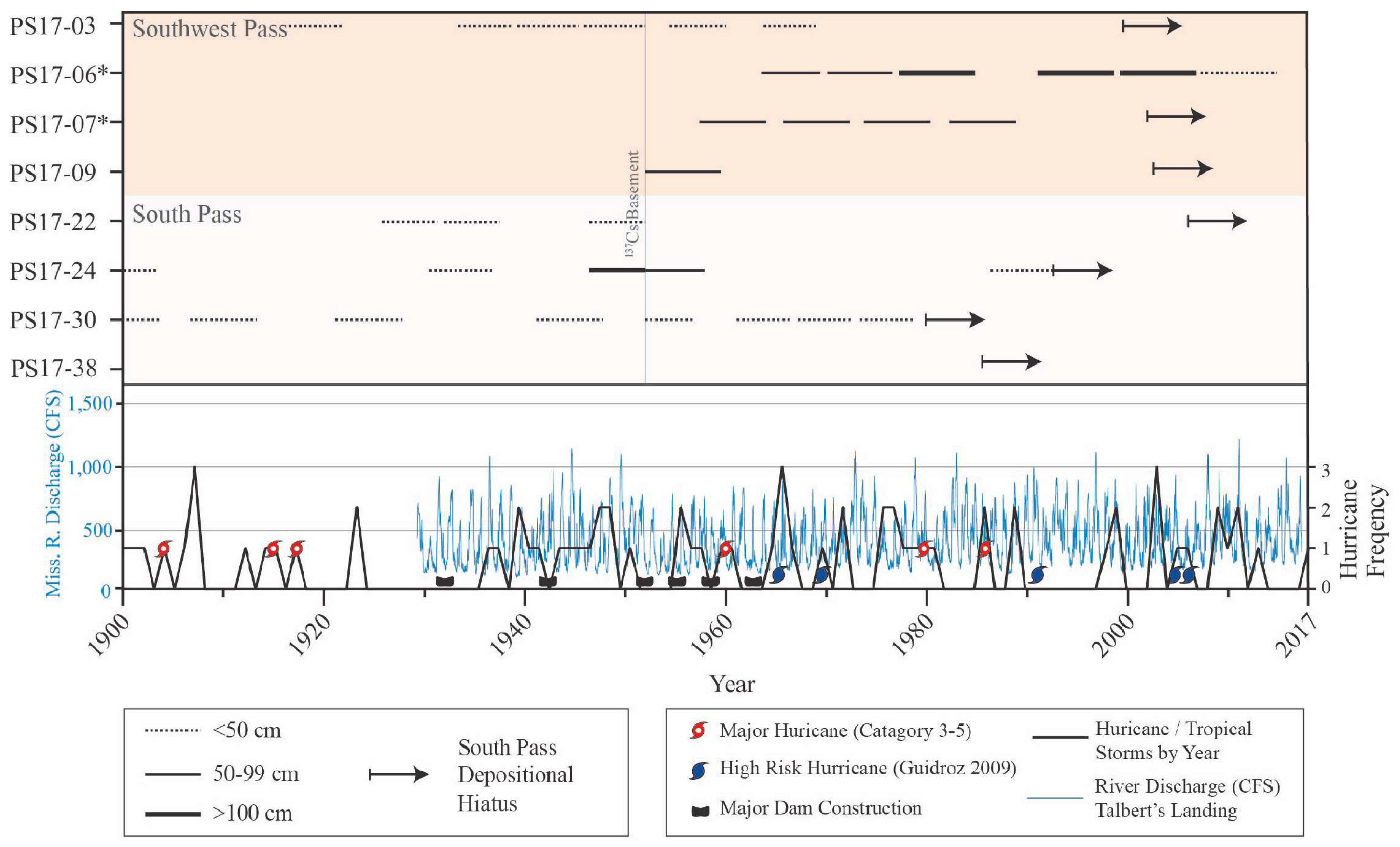
| Location (Pass) | Station | Facies | Distance from Pass (km) | Depth (m) | Average | 137Cs Penetration Depth (cm ± 6) | 137Cs SAR (m/decade) | 210Pb | Age of Deposit (years) | Year of Recent SAR Shift | |||
|---|---|---|---|---|---|---|---|---|---|---|---|---|---|
| Gamma Density (g/cm3) | Porosity | Grainsize (Φ) | SAR (m/decade) | R2 (Equation (1)) | |||||||||
| South West Pass | PS17-03 | Und | 12.48 | 67.7 | 1.56 | 0.69 | 7.1 | 144 | 0.27 | 0.42 | 0.76 | 125 ± 2.9 | 1999 ± 2.9 |
| PS17-06 | Gul | 10.05 | 55.8 | 1.45 | 0.75 | 6.91 | 552 | ≥0.94 | 1.28 | 0.45 | ≥64 ± 0.9 | N/A | |
| PS17-07 | Lob | 11.99 | 80.5 | 1.42 | 0.77 | 7.44 | 576 | ≥0.86 | 0.88 | 0.61 | ≥64 ± 1.1 | 2007 ± 1.1 | |
| PS17-09 | Pro | 15.89 | 86.3 | 1.49 | 0.73 | 7.58 | 288 | 0.54 | 0.79 | 0.6 | 74 ± 1.5 | 2006 ± 1.5 | |
| Average | 12.6 | 72.5 | 1.48 | 0.74 | 7.26 | 390 | 0.65 | 0.84 | 0.61 | 82 | |||
| South Pass | PS17-22 | Und | 16.73 | 154.2 | 1.52 | 0.71 | 7.64 | ND | ND | 0.19 | 0.72 | 775 ± 6.18 | 2005 ± 6.18 |
| PS17-24 | Gul | 17.02 | 149.4 | 1.54 | 0.7 | 7.42 | 144 | 0.28 | 0.26 | 0.61 | 329 ± 2.34 | 1993 ± 2.34 | |
| PS17-30 | Lob | 18.4 | 179.5 | 1.52 | 0.71 | 7.72 | 240 | 0.46 | 0.57 | 0.55 | 161 ± 1.13 | 1980 ± 1.13 | |
| PS17-38 | Pro | 22.12 | 252 | 1.69 | 0.61 | 7.94 | 18 | 0.04 | 0.08 | 0.92 | 673 ± 7.5 | 1985 ± 7.5 | |
| Average | 18.57 | 183.8 | 1.57 | 0.68 | 7.68 | 134 | 0.26 | 0.3 | 0.69 | 485 | |||
| Location (Pass) | Station | Facies | 210Pb Inventory | 210Pb Focusing Index (R) |
|---|---|---|---|---|
| South West Pass | PS17-03 | Und | 713 | 2.72 |
| PS17-06 | Gul | 2300 | 10.6 | |
| PS17-07 | Lob | 308 | 0.99 | |
| PS17-09 | Pro | 827 | 2.47 | |
| Total | 4149 | |||
| Average | 1037 | 4.2 | ||
| South Pass | PS17-22 | Und | 234 | 0.39 |
| PS17-24 | Gul | 689 | 1.19 | |
| PS17-30 | Lob | 866 | 1.25 | |
| PS17-38 | Pro | 859 | 0.88 | |
| Total | 2650 | |||
| Average | 662 | 0.93 |
| Location (Pass) | Station | Facies | Distance from Pass (km) | Depth (m) | Depositional Environment (%) | SAR (m/decade) | Mudflow | ||||
|---|---|---|---|---|---|---|---|---|---|---|---|
| Hypopycnal | Gravity Driven | Hydrodynamic | Quantity Per Core | Thickness Ave. (cm) | Event Return Period (Years) | ||||||
| South West Pass | PS17-03 | Und | 12.5 | 67.7 | 75.9 | 21.9 | 2.1 | 0.4 | 6 | 19.2 | 21 |
| PS17-06 | Gul | 10.0 | 55.8 | 7.7 | 92.3 | 0 | 1.3 | 6 | 98 | 11 | |
| PS17-07 | Lob | 12.0 | 80.5 | 43.9 | 56.0 | 0 | 0.9 | 4 | 77.3 | 16 | |
| PS17-09 | Pro | 15.9 | 86.3 | 71.0 | 23.4 | 5.5 | 0.8 | 3 | 45.7 | 24 | |
| Average | 12.6 | 72.5 | 49.6 | 48.4 | 1.9 | 0.8 | 4.8 | 60.0 | 18 | ||
| South Pass | PS17-22 | Und | 16.7 | 154 | 90.2 | 9.0 | 0 | 0.2 | 3 | 22.7 | 250 |
| PS17-24 | Gul | 17.0 | 149 | 66.7 | 31.7 | 0 | 0.3 | 5 | 53.6 | 67 | |
| PS17-30 | Lob | 18.4 | 179 | 79.0 | 20.8 | 0 | 0.6 | 8 | 22.1 | 20 | |
| PS17-38 | Pro | 22.1 | 252 | 74.3 | 30.3 | 0 | 0.1 | 4 | 40.8 | 167 | |
| Average | 18.6 | 184 | 77.6 | 23.0 | 0 | 0.3 | 5 | 34.8 | 126 | ||
| Depositional Mechanism | Diagnostic Characteristics | Occurrence (2017 Study) | ||
|---|---|---|---|---|
| Gamma Density/Grain Size | 210Pb/137Cs Geochronology | Fabrics (X-Radiography) | ||
| Hypopycnal Fluvial Sedimentation | Gradual increase in gamma density with depth due to consolidation (1.0–1.6 g/cc); No appreciable varriation in GS downcore | 210Pb shows exponensial regression with undisturbed, gradually deposited sediment; 137Cs shows no corelation with Hypopyccal seimentary structures | Fabrics show laminated to massive bedding generally lacking gas voids at the surface with gas voids present down core (below ~300 cm) | PS17-03 55 cm (Apron) PS17-07 60 cm (Lobe) PS17-38 30 cm (Prodelta) |
| Hydrodynamic Sedimentation Event | Increased magnetude spike surpassing bckground sawtooth fluctuation with excursions of ≥2.0 g/cc (cm scale); GS fluctiuation ≤6 ɸ | Reduction in 210Pb/137Cs activity due to scavenging occuring. Nature of cm scale event layers limit geochronology indicators | Event layers show a contact with higher contrast sand layers present. Both planar and convolute bedding differentially effected by local bioturbation | PS17-03 20 cm (Apron) PS17-09 52 cm (Prodelta) |
| Gravity Driven Sedimentation | “Stairstep Profile” Marked decrease (0.2–0.5 g/cc) from overlying profile with a sharp boundary on the lower sediment contact: GS following generally at lower magnetude | "Stairstep Profile" Marked decrease in unsupported 210Pb with a sharp boundary on the lower contact; 137Cs though not a direct indicator, is cut off at the lower 210Pb mudflow base | Fabrics show high constituents of organic material (mm scale) through the sediment layer with a sharp unconformity present at the base | PS17-06 315 cm (Gully) PS17-07 115 cm (Prodelta) PS17-24 162 cm (Gully) |
Disclaimer/Publisher’s Note: The statements, opinions and data contained in all publications are solely those of the individual author(s) and contributor(s) and not of MDPI and/or the editor(s). MDPI and/or the editor(s) disclaim responsibility for any injury to people or property resulting from any ideas, methods, instructions or products referred to in the content. |
© 2024 by the authors. Licensee MDPI, Basel, Switzerland. This article is an open access article distributed under the terms and conditions of the Creative Commons Attribution (CC BY) license (https://creativecommons.org/licenses/by/4.0/).
Share and Cite
Duxbury, J.; Bentley, S.J.; Xu, K.; Jafari, N.H. Temporal Scales of Mass Wasting Sedimentation across the Mississippi River Delta Front Delineated by 210Pb/137Cs Geochronology. J. Mar. Sci. Eng. 2024, 12, 1644. https://doi.org/10.3390/jmse12091644
Duxbury J, Bentley SJ, Xu K, Jafari NH. Temporal Scales of Mass Wasting Sedimentation across the Mississippi River Delta Front Delineated by 210Pb/137Cs Geochronology. Journal of Marine Science and Engineering. 2024; 12(9):1644. https://doi.org/10.3390/jmse12091644
Chicago/Turabian StyleDuxbury, Jeffrey, Samuel J. Bentley, Kehui Xu, and Navid H. Jafari. 2024. "Temporal Scales of Mass Wasting Sedimentation across the Mississippi River Delta Front Delineated by 210Pb/137Cs Geochronology" Journal of Marine Science and Engineering 12, no. 9: 1644. https://doi.org/10.3390/jmse12091644
APA StyleDuxbury, J., Bentley, S. J., Xu, K., & Jafari, N. H. (2024). Temporal Scales of Mass Wasting Sedimentation across the Mississippi River Delta Front Delineated by 210Pb/137Cs Geochronology. Journal of Marine Science and Engineering, 12(9), 1644. https://doi.org/10.3390/jmse12091644








